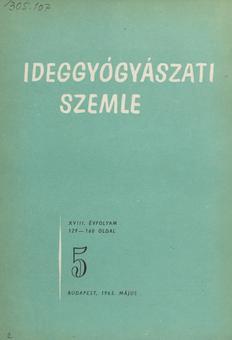The eLitMed.hu medical portal uses computer cookies for convenient operation. Detailed information can be found in the Cookie-policy.
Clinical Neuroscience - 1965;18(05)
Content
[The influence of Károly Schaffer on the development of neurology and neuropathology]
[He was the child of the sculptor Károly Schaffer; forms and shapes also captured his attention, but behind them he immediately sought content and meaning. His lifework therefore became an example of the close interweaving of facts and ideas.]
[The general neuropathological work of Károly Schaffer]
[Károly Schaffer was first commemorated by his admirers on the occasion of the fortieth anniversary of his literary activity, in October 1927. In his words of thanks, he expressed his pleasure that this occasion had been chosen to welcome him: while the usual anniversaries are determined by external circumstances, often by chance, the date on which one begins one's academic work is closely linked to one's personality.]
[The relationship between lipids in the brain and blood]
[Changes in the ratio of lipids in the blood to each other, or other changes in the blood, may be followed by abnormal changes in the brain. On the other hand, primary diseases of the brain may cause abnormal changes in the lipids of the blood. Austin's finding that in metachromatic leukodystrophy metachromatic staining lipoids are excreted in the urine is an important finding in the diagnosis of neurological diseases.]
[The works of Károly Schaffer on suggestion and reflexes]
[Schaffer summarises his final conclusions in the following sentences : 1. Intrahypnotic contractures are brain reflexes, but they can be influenced associatively. 2. The extent of a negative hallucination does not remain confined to the corresponding sensory cortical area, but spreads over the whole of the same hemisphere, with varying degrees of intensity. 3. Hysterical stigmata (deafness, blindness, anaesthesia, etc.) are not caused by dynamic damage to the corresponding central sensory areas, but are a disturbance (delusion ?) of the associative mechanism. ]
[Amyotrophic lateral sclerosis in the light of recent research]
[35 years ago, in 1929, one of us in the histology laboratory of the Schaffer Clinic worked up an interesting case, which we observed clinically together for 2 years. Without going into details, we will summarise the essence of the clinical investigation.]
[Alzheimer's disease-like fibril lesion in circumscribed brain atrophy]
[The author discusses the pathophysiological and histopathological differential diagnosis of Pick's disease and Alzheimer's disease. He describes a case with a slow progression over 6 years, first classified as Pick's disease on the basis of moral personality changes, spontaneity, vocabulary loss and lack of disease insight, and later as Alzheimer's disease on the basis of dementia, mild aphasia and motor dysfunction. Asymmetric and eunomic cortical atrophy of the brain, as well as sparing of the projection areolae, the high number of AFEs in the atrophied cortex and the integrity of the fronto-pontine pathway were considered from the perspective of the possibility of Alzheimer's disease. Histochemical examination of AFE did not allow him to reach a definite conclusion. Although the author considers Pick's disease and Alzheimer's disease to be independent nosological entities, he rarely considers their symptomatic confusion to be possible.]
1.
Clinical Neuroscience
[Headache registry in Szeged: Experiences regarding to migraine patients]2.
Clinical Neuroscience
[The new target population of stroke awareness campaign: Kindergarten students ]3.
Clinical Neuroscience
Is there any difference in mortality rates of atrial fibrillation detected before or after ischemic stroke?4.
Clinical Neuroscience
Factors influencing the level of stigma in Parkinson’s disease in western Turkey5.
Clinical Neuroscience
[The effects of demographic and clinical factors on the severity of poststroke aphasia]1.
2.
3.
4.
5.



